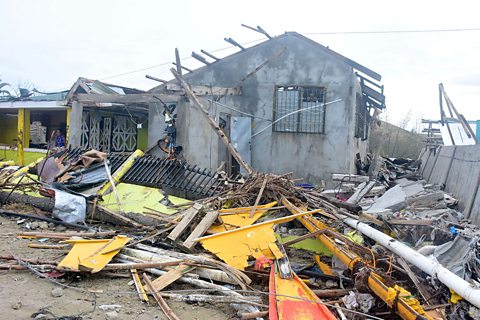Tropical storm case study - Typhoon Rai
Typhoon Rai (also known locally as ÔÇ£OdetteÔÇØ) was a tropical storm that affected the Philippines in December 2021. The Philippines is a lower-middle income country in Southeast Asia. With wind speeds of 195 km/h, Typhoon Rai was a Category 5 tropical storm, which was later named a 'super-typhoon.' In some parts of the country, over 150 cm of rainfall was recorded in just three days.
Typhoon Rai hit Siargao Island in eastern Philippines at 1.30pm on Thursday 16th December. By 3.10pm on Friday 17th December, the typhoon had moved west to Palawan, before travelling out into the South China Sea.
Impacts
Economic
- The overall economic impact of Typhoon Rai is estimated at around $550 million (£435 million).
- Crops and food supplies were washed away, affecting the country's international trade and farmers' incomes.
- Many flights were cancelled and dozens of ports were closed, affecting business and tourism.
- The fishing industry was severely affected with the storm destroying boats and associated equipment worth over $58 million.
Social
- By January 2022, 407 people were killed, 78 people were still missing and nearly 1,150 people had been injured by the storm.
- The storm affected 11 of the PhilippinesÔÇÖ 17 regions. The lives of more than seven million people were disrupted.
- 36 million homes were damaged or destroyed. More than half a million people were left homeless over the Christmas period.
- There were outbreaks of diarrhoea and other diseases due to the lack of sanitation, food, water, shelter, and medication.
- Thousands of people were housed in temporary shelters, many without running water or sanitation.
Environmental
- Widespread floods damaged and in many cases destroyed homes and businesses in coastal areas.
- Farmland was damaged by strong winds and flooding.
- Thousands of trees were uprooted leading to a massive release of carbon dioxide and loss of habitat with resulting effects on wildlife.
- Protected areas, including Puerto Princesa Subterranean River National Park (PPSRNP) and El Nido-Taytay Managed Resource Protected Area, were damaged.
- Major roads were blocked by trees, and were impassable.

Responses
Typhoon Rai rapidly grew into a super-typhoon. Although its path was tracked, the storm exceeded all predictions. On the 21st December, the Philippines formally declared 'A State of National Calamity' and asked for international help.
The countryÔÇÖs military, coast guard and fire personnel brought aid and assistance to the worst-affected areas. Military aircraft and naval vessels were used to find survivors and distribute supplies.
Charities such as Oxfam, M├®decins Sans Fronti├¿res (MSF), CAFOD and ShelterBox raised money for essential supplies, such as medication and shelter. In the longer term, these charities are helping people get their livelihoods back, for example by repairing fishing boats or distributing rice seeds.
The United Nations initially launched an international aid appeal for $107m to finance the humanitarian relief effort. One month after the storm it was clear that the situation in the Philippines was more serious than they first thought, so they increased this figure to $169m.